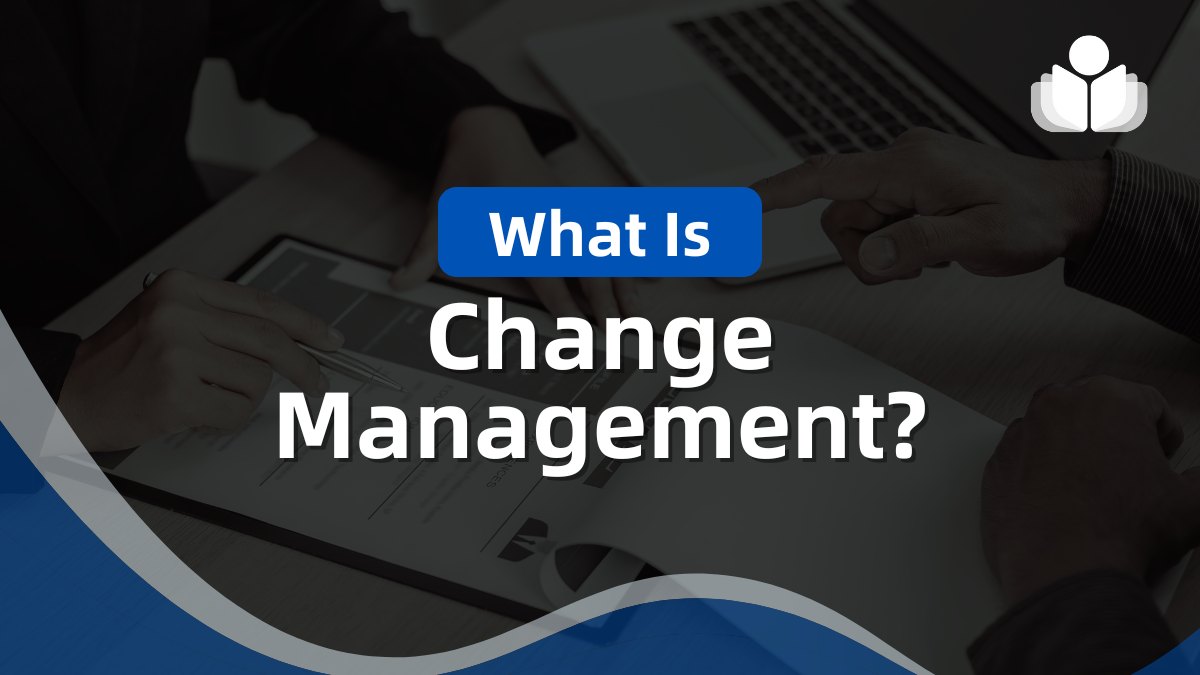Change management refers to the structured approach that helps guide individuals, teams, and organizations from their current state to a desired future state. The goal is to ensure that transitions happen smoothly, minimizing resistance and improving the chances of success. Whether introducing new processes, technology, or organizational changes, change management is essential in managing the human side of these transformations.
In today’s fast-paced world, change management is crucial as companies constantly need to adapt to new technologies, evolving market trends, or regulatory requirements. Without a clear change management strategy, organizations can face resistance, low morale, and ineffective implementation of necessary changes.
Change management is relevant across all industries and organizations, regardless of size. Whether rolling out new software, changing business strategies, or restructuring your company, a well-defined approach to change is key to driving success.
Types of Organizational Changes
Organizational changes come in many forms, and each type presents its own unique challenges and opportunities.
- Strategic Changes: Strategic changes involve shifts in a company’s long-term goals or business direction. Examples include entering a new market, adopting a new business model, or pivoting from one product to another. These shifts are crucial to remaining competitive but often require significant organizational adjustments.
- Technological Changes: Technological changes occur when new technology or tools are introduced. This could include adopting cloud computing, automation, or integrating new software into business operations. Such changes impact workflows, requiring employees to learn new systems and adapt to digital transformations.
- Structural Changes: These involve altering the organization’s hierarchy or reporting structures. This can occur during mergers, acquisitions, or downsizing and can significantly impact how teams operate, often requiring a redefinition of roles and responsibilities.
- Cultural Changes: Cultural changes aim to shift an organization’s underlying values, behaviors, or beliefs. For example, promoting a more inclusive workplace or encouraging innovation represents cultural change, often taking time and effort to embed into the company’s DNA fully.
- Process Changes: Process changes focus on improving efficiency and productivity. Whether by re-engineering workflows, adopting lean methodologies, or improving customer service practices, these changes help optimize work.
The Role of Change Management
Change management is essential for ensuring that change initiatives align with organizational goals and are effectively implemented.
- Supporting Organizational Goals: Change management ensures that change initiatives support and align with an organization’s strategic objectives. It helps keep all stakeholders working toward the same outcomes, ensuring the change moves the organization closer to its desired future state.
- Reducing Resistance to Change: One key change management role is minimizing resistance. Employees often fear change because it can bring uncertainty, disrupt routines, or even result in job loss. Effective change management addresses these concerns by providing support, fostering understanding, and actively involving employees.
- Improving Communication and Transparency: Clear communication is at the heart of change management. Keeping employees informed throughout the process reduces uncertainty and builds trust. Transparent communication ensures that employees understand why the change is happening, their role, and how it will benefit them and the organization.
- Enhancing Employee Engagement: Change management fosters employee engagement by involving staff in decision-making and planning. When employees are actively engaged and feel their input is valued, they’re more likely to support and embrace the changes.
- Risk Management and Mitigation: Effectively managing change also means identifying and mitigating potential risks. These can include technical challenges, productivity loss, or a negative impact on employee morale. Anticipating these risks and having a plan to address them helps ensure a smoother transition.
The Change Management Process
Change management follows a structured process to ensure a successful transition.
Step 1: Preparing for Change
The first step in change management involves understanding the scope of the change and developing a clear vision of the desired future state. Impact assessments help identify key stakeholders and areas of the organization that will be affected. This phase is crucial for setting the foundation for a smooth transition.
Step 2: Planning the Change
Once the scope is clear, change managers create a detailed plan that outlines the steps needed to implement the change. This includes timelines, resource allocation, and communication strategies to ensure that all parts of the organization are aligned.
Step 3: Implementing the Change
In this phase, the change is rolled out across the organization. Change managers must address any issues that arise during this phase, making real-time adjustments where necessary. Training and support play a key role in helping employees adapt.
Step 4: Managing Resistance
Resistance is expected during the implementation phase. Change managers must actively address concerns by providing training, offering support, and creating feedback loops where employees can voice their concerns.
Step 5: Reinforcing the Change
Once the change has been implemented, ensure that the new processes or behaviors become embedded in the organization. This phase includes reinforcing the change through follow-up communication, measuring the results, and addressing any areas that need improvement.
Step 6: Reviewing and Refining
Finally, the change management process is evaluated to assess the initiative’s success. Employee feedback is gathered, and any gaps are identified and addressed for future improvements. Continuous learning is a key part of refining the change management process.
Key Models of Change Management
Several models guide change management, each offering unique insights into handling organizational transitions.
ADKAR Model
The ADKAR model (Awareness, Desire, Knowledge, Ability, Reinforcement) focuses on individual change. Each step corresponds to a stage in the process of personal transformation, emphasizing the importance of communication, training, and reinforcement to ensure successful change adoption.
Kotter’s 8-Step Change Model
John Kotter’s model emphasizes the emotional and cultural aspects of change. It begins with creating a sense of urgency and follows with steps like building a coalition, developing a vision, and anchoring the change in the company culture. This model is helpful for large-scale organizational changes.
Lewin’s Change Management Model
Kurt Lewin’s model consists of three stages: Unfreeze, Change, and Refreeze. This simple yet effective model highlights the importance of preparing for change, implementing the transition, and solidifying the new processes to ensure they stick.
McKinsey 7S Framework
This model addresses seven interrelated elements of an organization: Strategy, Structure, Systems, Shared Values, Skills, Style, and Staff. The 7S framework ensures that all aspects of an organization are aligned and work cohesively during a change initiative.
Bridges Transition Model
William Bridges’ model focuses on individuals’ psychological transition during change. It distinguishes between the external change and the internal emotional transition, helping leaders address the emotional challenges of organizational change.
Challenges in Change Management
Resistance from employees is one of the most common obstacles in change management. Employees may resist due to fear of the unknown, concerns about job security, or feeling left out of the process. To overcome this, it’s essential to communicate clearly, involve employees in the transition, and show empathy for their concerns. Listening to their feedback can ease anxiety and foster a sense of inclusion.
Poor communication is another major hurdle. If change isn’t explained well, it can lead to confusion, rumors, and a lack of trust. Effective change management requires frequent, transparent communication at every process stage. Regular updates and an open-door policy can help alleviate uncertainty.
Inadequate leadership support can doom a change initiative. Without a visible commitment from top leaders, employees may feel that the change is not a priority. Securing leadership buy-in is crucial for successful implementation. Leaders should actively endorse and participate in the change to show its importance.
Many organizations need to pay more attention to the complexity of change. Change affects processes and people’s emotions, work habits, and routines. A comprehensive change plan must account for the time, resources, and emotional support needed to help employees adapt.
Measuring success should be noticed. With clear KPIs, assessing whether a change initiative has achieved its goals is easy. Post-change reviews and data-driven analysis can provide insights into the effectiveness of the change and areas for improvement.
Tools and Techniques for Effective Change Management
Change management software, such as Prosci, ChangeGear, or Gensuite, offers structured platforms to manage the entire change process. These tools help track progress, manage communication, and monitor employee adoption, ensuring changes stay on schedule.
Surveys and feedback tools, such as focus groups or one-on-one interviews, are essential for gathering employee insights during a change initiative. Regular feedback allows leaders to spot issues early and adjust the strategy to meet employee needs better.
Communication platforms like Slack, Microsoft Teams, or intranet systems provide a centralized hub for keeping employees informed throughout the change process. These platforms ensure that updates, FAQs, and announcements are easily accessible to all staff.
Training programs, workshops, and e-learning platforms help employees acquire the skills to adapt to new systems or workflows. Offering hands-on training reduces anxiety and accelerates the adoption of changes.
Project management tools, such as Asana, Trello, or Jira, help leaders plan and monitor the change process. These tools organize tasks, set deadlines, and assign responsibilities, ensuring that each step of the change initiative is completed on time.
The Future of Change Management
Digital transformation reshapes industries, and change management must adapt to this new reality. The rise of artificial intelligence, automation, and cloud computing is pushing companies to evolve rapidly. Effective change management will be critical to managing these shifts and ensuring smooth transitions.
The increase in remote work also affects change management strategies. Engaging employees virtually during transitions requires new communication tools and techniques to maintain team cohesion and commitment during remote changes.
Sustainability and ethical considerations are becoming more prominent in business strategies, and future change management will need to incorporate these elements into decision-making. Organizations will need to align their changes with environmental goals and social responsibility.
Data-driven change management will become increasingly important as companies use analytics to predict outcomes, track progress, and make informed decisions. Leveraging data will allow change leaders to monitor initiatives’ impact in real-time and adjust strategies as needed.
Conclusion
Change management is the structured approach organizations use to transition from their current state to a desired future state. This process involves expecting resistance, communicating clearly, and aligning change initiatives with organizational goals.
Although change can be challenging, organizations that adopt a thoughtful, structured approach can overcome obstacles and achieve long-term success. By engaging employees, securing leadership support, and using data-driven tools, change becomes manageable and a driver of growth and innovation. For companies and individuals alike, effective change management is key to thriving in an ever-evolving world.
 Sections of this topic
Sections of this topic
















